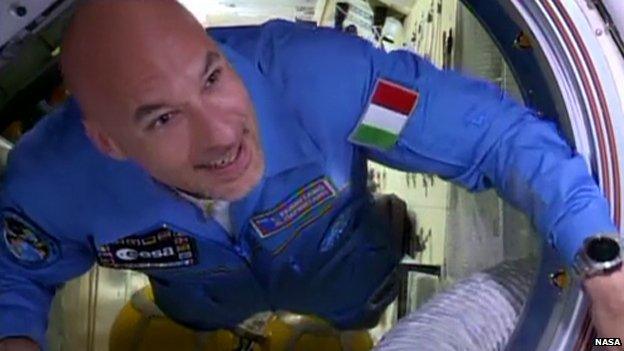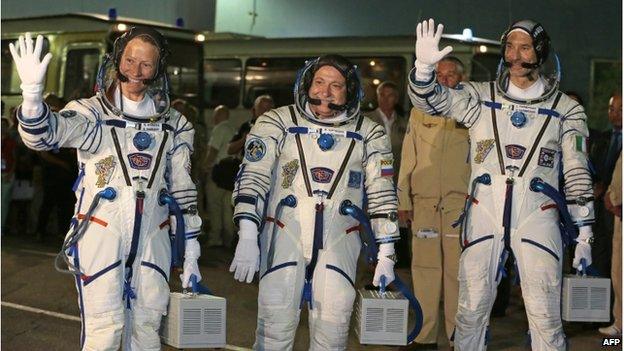Soyuz takes new crew to International Space Station
- Published

Luca Parmitano floats through the hatch into the International Space Station
Three new crew members have arrived at the International Space Station (ISS) after launching from Kazakhstan.
The Soyuz rocket carrying Fyodor Yurchikhin, Karen Nyberg and Luca Parmitano lifted away from the Baikonur Cosmodrome at 02:31 local time on Wednesday (20:31 GMT Tuesday).
Russian Yurchikhin and American Nyberg have both been into space before. Italian Parmitano is a first-timer.
They arrived at the orbiting platform five hours and 46 minutes later.
Their Soyuz capsule was using a new flight profile that dramatically reduces the rendezvous time from the traditional two days.
It is technically more difficult and requires some very precise orbital adjustments, but it is deemed to be easier on the crew because it means they do not have to spend so long inside their cramped vehicle.
Leak and pressure checks were conducted following docking at the station, with a hatch opening, external at 04:14 GMT.
Fyodor Yurchikhin, Karen Nyberg and Luca Parmitano lift off on their six hour flight to the International Space Station
The trio, whose designation is Expedition 36, external, were greeted with hugs and smiles by the three individuals already on the ISS - Russians Pavel Vinogradov and Alexander Misurkin, and American Chris Cassidy.
The new crew members will be given a week of light duties in which to acclimatise to their weightless surroundings. Work will then begin in earnest.
Luca Parmitano's participation in this expedition is particularly notable.
At 36, he is the youngest person to get a long-duration (six months) stay on the station. He is also the first of the European Space Agency, external's (Esa) new intake of astronauts to get a flight assignment.
Selected in 2009, the former fighter pilot has a packed schedule ahead of him.
ISS crews are now completing about 70 hours a week of science, conducting experiments that exploit the unique microgravity environment on the platform.
Russian Soyuz rocket docks at the International Space Station
Parmitano has a package of specific European activities to work through, which cover fields as diverse as fluid physics and materials science.
The Italian will see all of the vehicles now used to service the station come and go during his time in orbit, including possibly the new Cygnus freighter which is made in part in the Italian city of Turin.
He is also scheduled to make two spacewalks to work on the exterior of the platform.
"I've dreamt of doing that. Being an astronaut is about walking in space. For me, they are one and the same thing," he told BBC News.
One of the spacewalks will help prepare the ISS for the arrival of Russia's big science laboratory, which will grow the 420-tonne complex still further.
The lab will come up with Europe's major robotic contribution to the platform - a large arm that is able to move around the station to conduct work wherever it is needed.
Born in the Sicilian town of Paterno, Parmitano expects to bring a strong Italian flavour to his stay in orbit - literally. Italian chefs have prepared a range of special astronaut foods for him, including lasagne and risotto.
These will be delivered to the ISS in the coming weeks on the European robotic freighter Albert Einstein.
Fyodor Yurchikhin, Karen Nyberg and Luca Parmitano are due back on Earth on 10 November.

Karen Nyberg (L), Fyodor Yurchikhin (C), and Luca Parmitano (R) will stay in orbit until November
Jonathan.Amos-INTERNET@bbc.co.uk and follow me on Twitter: @BBCAmos, external
- Published27 May 2013
- Published29 May 2013
- Published20 May 2013
- Published16 May 2013
- Published18 February 2011
- Published22 November 2010